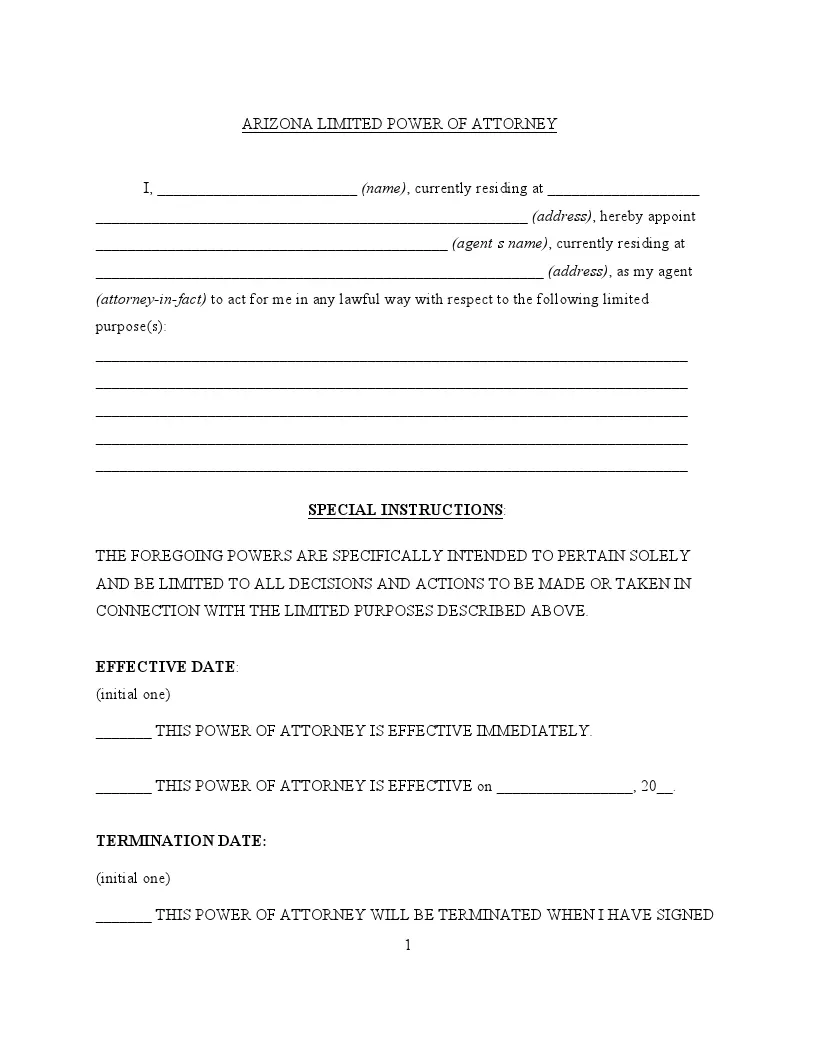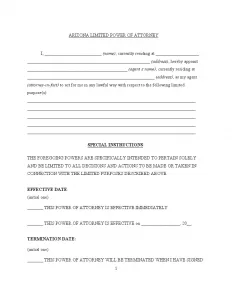Arizona Limited Power of Attorney Form
An Arizona limited power of attorney is a legal document that gives someone, called the agent or attorney-in-fact, the authority to act on behalf of another person, known as the principal, but only in certain circumstances or for particular tasks. This arrangement is used when the principal needs representation for a single transaction or a defined series of actions over a limited period. Examples include handling real estate transactions or managing financial affairs during a specified time frame when the principal is unavailable.
In Arizona, while there isn’t a designated statutory form for a limited power of attorney, the durable POA can be adapted to outline specific authorities the principal intends to delegate to the agent. This form includes a section where the principal can detail the exact powers being granted. For instance, the principal might allow the agent to manage financial accounts, like checking and savings, excluding retirement funds, or to handle specific assets, such as real estate deeds but not automobile titles.
Get Arizona power of attorney forms — click to view and complete all the available POA templates for this state.

Build Your Document
Answer a few simple questions to make your document in minutes
Save and Print
Save progress and finish on any device, download and print anytime
Sign and Use
Your valid, lawyer-approved document is ready
The laws governing the signing requirements and legalities of a limited power of attorney are detailed in Title 14, Chapter 5 of the Arizona Revised Statutes (§ 14.5501 – 14.5507). Specifically, § 14.5501 outlines the definitions and the signing requirements critical for executing a valid limited power of attorney.
According to the statute, the principal must sign the document. Additionally, this signing must occur in the presence of a witness and be officially notarized by an individual authorized to perform such acts. It ensures the document is legally binding and the principal’s intentions are verified. Key points of consideration include:
- The presence of a witness during the signing.
- Notarization by an authorized official.
- Adherence to the specified terms within the power of attorney form.
Furthermore, § 14.5504 addresses the revocation process, allowing the principal to withdraw the powers granted through the limited power of attorney at any time, provided the revocation process outlined in the statutes is followed. This provision ensures that the principal retains ultimate control over the authority granted and can terminate it when their circumstances or intentions change.
Arizona Limited Power of Attorney Form Details
| Document Name | Arizona Limited Power of Attorney Form |
| Other Name | Arizona Special Power of Attorney |
| Relevant Laws | Arizona Revised Statutes, Sections 14-5501 to 14-5507 |
| Avg. Time to Fill Out | 8 minutes |
| # of Fillable Fields | 32 |
| Available Formats | Adobe PDF |
Filling Out Arizona Limited POA
Completing an Arizona limited power of attorney form allows you to designate someone to act on your behalf for specific tasks. This guide will walk you through the steps to fill out this template accurately, making the document legally binding and effective.
1. Identify the Principal and Agent
Begin by filling in your name and address as the principal, and specify the name and address of the person you appoint as your agent (attorney-in-fact). This person will have the authority to act on your behalf.
2. Define the Powers Granted
Clearly list the specific powers you are granting to your agent. These should be detailed to prevent any power misuse and ensure clarity in what the agent is authorized to do.
3. Set the Effective Date
Choose when the powers will become effective. You can have the power of attorney take effect immediately or specify a future date.
4. Determine the Termination Date
You can choose from the following options:
- Signing a written revocation.
- A specific date in the future.
- Upon your incapacitation, as defined in the document.
Decide when the power of attorney will end.
5. Appoint a Successor Attorney-in-Fact
If your first choice for an agent is unable or unwilling to serve, you can designate an alternate agent. Fill in the name and address of the successor attorney-in-fact.
6. Sign and Witness
Sign the form in the presence of a witness and have it notarized by an authorized official. This step is crucial as it validates the document.
7. Notarization
Take the document to a notary public. The notary will verify your identity and ensure you sign the form willingly and under no duress. The notary will then seal the document, making it legally binding.
